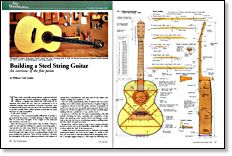Building a Steel String Guitar
An overview of the fine points
Synopsis: William “Grit” Laskin advises readers to set aside thoughts of instrumentmaking as being too tough or not enough about furniture. Here, he covers the trickier and most troublesome processes in making a steel-string guitar (a thorough explanation would fill up a book). Laskin talks about general theories of guitar design that guide selection of materials, and brings readers to the first assembly stages dealing with the soundboard, or top, and the back. An extensive drawing kicks off his explanations of the luthier process, and he details how the shape evolved, what materials are best to use, cutting strategies, joining tips, and further reading and suppliers.
There exists, especially among artisans, a general acknowledgement that musical instrument making is a singular endeavor, a category unto itself in the craft world. An instrument must please the eye, must be constructed so as to withstand perhaps many hundreds of pounds of pressure, must be playable with proper ease and, above all, must have the ability to produce tonally subtle, refined musical sounds that can reach the back of a hall unamplified.
A tall order? Perhaps.
If, however, it was an insurmountably difficult job to produce a good musical instrument, I wouldn’t attempt to help you do just that. So, resist those thoughts of “too tough” or “I’m really just into furniture” and read on.
This is the first part of a three-article series in which I intend to guide you through the building of a superior steel string guitar. I can’t provide you with every detail for each minute step in the process—for that, I’d need an entire book. What I will do as we move through each stage is focus on guitarmaking’s trickier and most troublesome processes. Short of brief mentions, I’ll leave the description of the more routine procedures to the authors of several fine, comprehensive texts that exist on the subject (see “Further reading and suppliers,” p. 49).
Part one of this guitarmaking series of articles—the one you’re reading now—will examine general theories of guitar design in conjunction with the needs that guide selection of materials. As you’ll soon see, the two are greatly interconnected. By the close of part one, I’ll have brought you to the very first assembly stages dealing with the soundboard, or top, and the back.
In part two, we’ll bite into the meat of guitarmaking. This will include bending the sides, assembly and completion of the frame (the glued-up sides, interior blocks and linings), a brief look at the top, the how-to of achieving seamless purfling joints and the critical dovetail neck joint.
By part three, we’ll be ready to look at those murky territories known as action and set-up (playability, string height, etc.—what is often called the “feel” of an instrument).
From Fine Woodworking #67
For the full article, download the PDF below:
Fine Woodworking Recommended Products

Suizan Japanese Pull Saw





















Log in or create an account to post a comment.
Sign up Log in